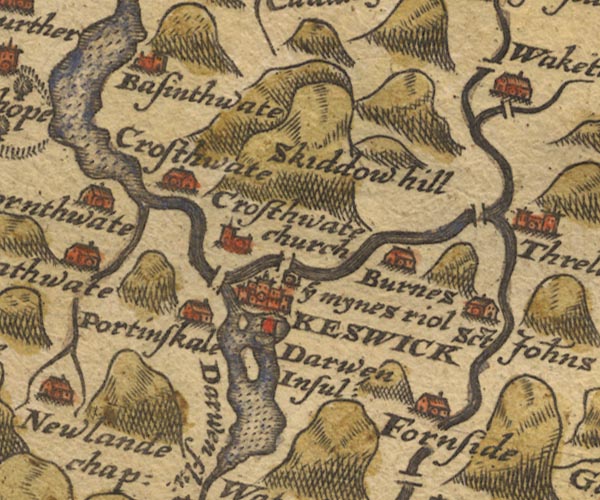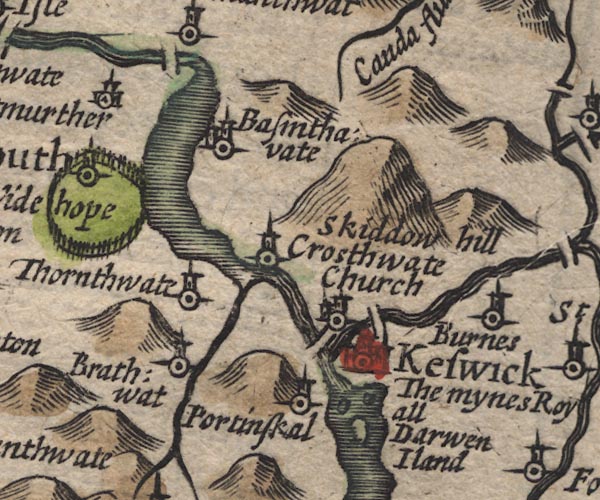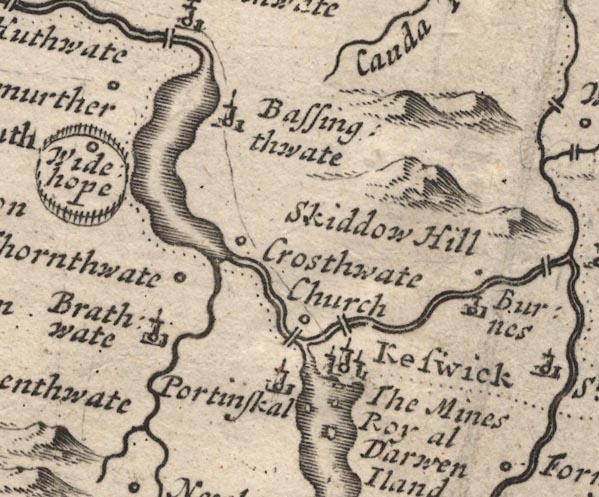




placename:- Mynes Riol, Ye

Sax9NY22.jpg
"ye mynes riol"
item:- private collection : 2
Image © see bottom of page
 goto source
goto sourcefirst page:- "... But the Mines Royall of Copper, whereof this Country yeeldeth much, is for use the richest of all: the place is at Keswick and Newland, ..."
placename:- Mynes Royall, The

SP11NY22.jpg
"The mynes Royall"
by Keswick or Derwent Island
item:- private collection : 16
Image © see bottom of page
placename:- Mines Royal, The

MD12NY22.jpg
"The Mines Royal"
No symbol, at Keswick.
item:- JandMN : 90
Image © see bottom of page
placename:- Dutch Huts
item:- copper ore; copper
 goto source
goto sourcePage 62:- "..."
"On the banks of this river [Greta], about half a mile from Keswick, have been several buildings, but hardly any tradition concerning their history. It is evident, however, that here has been a smelting mill for copper. A few years ago the surveyors of the high roads having set some men to repair this road, they found some pieces of copper ore, which was extremely rich; upon this men were employed to dig out and dress the slag which they found here, and which paid very well for their work. The walls of the old houses are now standing, and are four or five feet high. As it was commonly believed that the copper was brought from Newlands, some persons undertook a work there with very sanguine expectations: they made their trials on a hill called Goldscalp; but after a considerable waste of time and money, met with nothing. The only tradition I ever met with concerning these was from Benjamin Grisdale, a man near an hundred years old; he told me that he had heard his father say, that a company of Dutchmen wrought Newland Fells for copper; that they built a mill and some houses here, which went by the name of the Dutch Huts, and where they extracted gold from the copper: that they kept their works very secret; and, as they always spoke their own language, no one understood them. They staid till the place was not worth the working. This place shared the fate of most parts of this country, A.D. 1641, being burnt and destroyed. Inquire at Keswick for the Dutch Huts, and scarce any one can give you any intelligence concerning them. ..."
item:- Civil War; Cromwell, Oliver; copper
 goto source
goto sourcepage 74:- "In 1561 a Company was incorporated for the purpose of working Goldscope and Dale Head Mines, ... Extensive copper smelting works were erected in Keswick by this Company in 1565 and 1566, the largest in England, and probably in Europe at that"
 goto source
goto sourcepage 75:- "time. Six furnaces were in operation in 1567, supplied chiefly with ore from the mines in Newlands; but small quantities were also brought from Caldbeck and Coniston. ... The work was carried on principally by a colony of Germans. Robinson says, "The operators, managers, and miners were most of them Germans. The chief steward of the work was one Hechstetter, who by his books of accounts, which are most regular and exact, and all on large imperial paper, as well as by other writings under his hand, appears to have been a man of great learning as well as of great judgment in metals and minerals.""
"... These smelting works continued in active operation until 1650 or 1651, when they were destroyed during Oliver Cromwell's campaign in the north. They were afterwards partly rebuilt by a Company of Dutchmen, about 1690, and continued working until sometime after 1715. The site of these works is on the north-eastern side of the town of Keswick, on the bank of the river Greta, where quantities of slag and pieces of metallic copper may yet be found."
"J Fisher Crosthwaite, F.S.A., of Keswick, sought out from the Registers of Crosthwaite Church much valuable information respecting the births, marriages and deaths of the "German Miners," during their sojourn in Keswick and its vicinity, and embodied it in a Paper which appeared in the Transactions of the Cumberland and Westmorland Association, Vol.VIII. page 111."
"More recently, W. G. Collingwood, M.A., F.S.A., of Coniston, opened up a correspondence with the living descendants of the German Miners who lived in Keswick, worked at Goldscope and other local mines, built the smelting works and conducted the smelting operations. He found that all their account books, reports and other documents respecting their work at Keswick are still preserved in the archives of Augsburg, in Germany, to the extent of 12 volumes of manuscript. Mr. Collingwood obtained the loan of this material, arranged and classified it, and has published it in a most valuable and interesting book entitled "Elizabethan Keswick" (Published by Titus Wilson, Highgate, Kendal, 1912)."
: Company of Mines Royal
